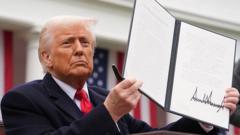In a significant development in international trade, President Donald Trump has struck a deal with Japan, marking a notable outcome from his unorthodox tariff strategies. Initially, negotiations with Japan seemed stagnant, yet recent discussions have yielded a deal that could influence global trade practices.
The newly established agreement is seen as a victory for Trump's administration, especially if Japan becomes a catalyst for other nations to align with US trade expectations. While the deal features a 15% tariff on Japanese imports—higher than the UK's 10%—Japan's existing trade surplus with the US gives it a unique status among trading nations.
Reports indicate that Japanese negotiators were notably assertive during discussions, which is a departure from their typically understated diplomatic interactions. The Japanese Finance Minister even referenced the nation's substantial $1.1 trillion US Treasury bond holdings as leverage in the negotiations.
The timing of this agreement is crucial; it coincides with Japan hosting EU leaders in Tokyo, potentially impacting discussions among European nations regarding their own trade strategies. The deal underscores a major shift, effectively stymying any coordinated retaliatory efforts from Japan, the EU, and Canada against US tariffs. This move might spark questions from EU members about striking similar agreements amidst increasing tensions with the US.
Despite the deal's successes, uncertainties remain. While Japan has managed to safeguard its agricultural imports, it has agreed to increase imports of US rice, and the appeal of American automobiles in Japan continues to be a hurdle. Nonetheless, Japanese companies are projected to invest around $500 billion in the US, a gesture aimed at bolstering economic ties.
Tokyo's decision to proceed with this deal may partly stem from domestic political dynamics, especially given Prime Minister Shinzo Abe's waning popularity. Other nations like Indonesia and the Philippines have also sought agreements with the US, possibly indicating a broader trend among countries to engage with Trump’s administration proactively.
In a broader context, Trump's approach marks an acceptance of the aggressive tariff landscape, even from traditional allies that are wary of retaliatory measures against US exports. Notably, tariffs have generated significant revenue for the US Treasury, marking over $100 billion this year alone—about 5% of federal revenue, significantly higher than the typical 2% figure.
However, concerns remain regarding who ultimately bears the financial burden of these tariffs, as US consumers may face increased costs for imported goods. While there were hopes a climbing dollar would alleviate these costs, the currency has instead depreciated against a spectrum of global currencies, complicating the situation further.
Recent comments from Bank of England Governor Andrew Bailey highlight a shifting landscape for the US dollar, suggesting traders are adjusting their strategies in response to its declining status as a safe haven currency. This change could benefit American manufacturers aiming to regain competitiveness, but also emboldens China as a potentially stable trade alternative.
For the Trump administration, securing a trade deal with Japan represents a significant morale boost. It counters narratives that the President falters under pressure and highlights the potential for further agreements as the administration approaches upcoming negotiation deadlines. Nevertheless, the overall economic landscape remains fraught with complexities, leaving many questions unanswered.






















